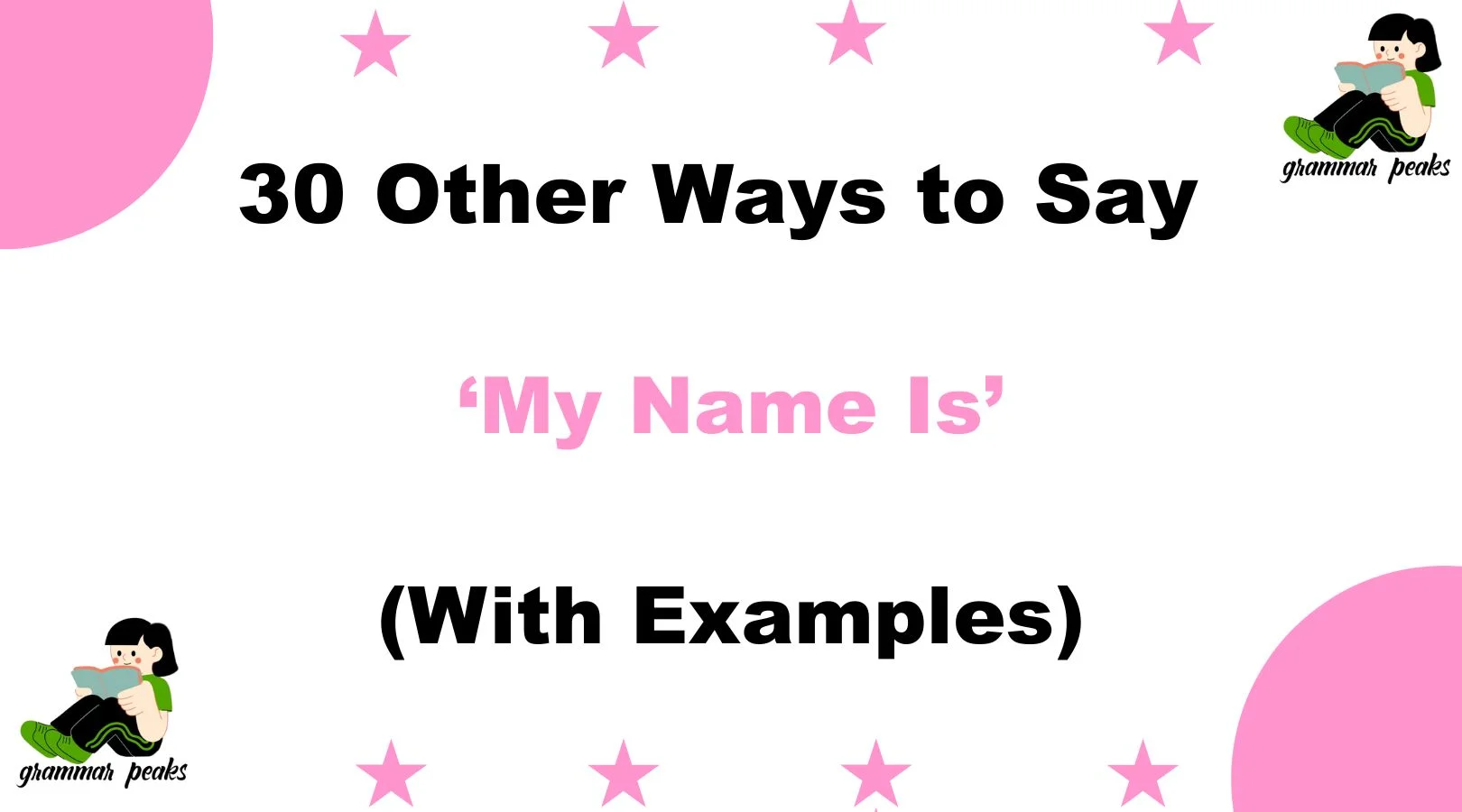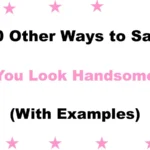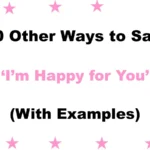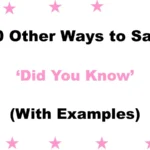Introducing yourself is one of the most important moments in communication. How you say “My name is” can set the tone for a conversation, build rapport, and show respect and warmth. Using different phrases to express your identity can make your introduction feel more personal, engaging, and thoughtful.
Whether you want to sound casual, formal, friendly, or creative, having a variety of ways to say “My name is” helps you connect meaningfully in any setting. In this article, you’ll find 30 alternatives to say “My name is,” each explained with examples, best uses, and tone tips to help you express yourself with care and confidence.
What Does “My Name Is” Mean?
“My name is” is a simple, direct phrase used to introduce yourself. It tells others what you’re called and helps begin a conversation or formal interaction. This phrase is common in greetings, introductions, interviews, and public speaking. For example, “My name is Sarah, and I’m your guide today.” It’s polite, clear, and widely understood across English-speaking cultures.
When to Use “My Name Is”
Use “My name is” when you want to:
- Formally or informally introduce yourself to new acquaintances.
- Establish your identity in conversations, meetings, or presentations.
- Clarify who you are in written or spoken communication.
Is It Professional/Polite to Say “My Name Is”?
Yes! Saying “My name is” is universally polite and professional. It shows respect and openness in communication. The phrasing can be adapted to suit formal or casual settings, making it versatile for all occasions.
Pros and Cons of Saying “My Name Is”
Pros:
- Clear and direct introduction.
- Easy to understand across cultures.
- Builds trust by sharing identity upfront.
Cons:
- May feel plain or uncreative in informal contexts.
- Can sound stiff if overused or delivered without warmth.
- Limits opportunities for unique self-expression.
Synonyms for “My Name Is”
- I am called
- I go by
- You can call me
- I’m known as
- This is [Name] speaking
- Allow me to introduce myself — I’m
- People call me
- I prefer to be called
- The name’s
- I answer to
- I’m referred to as
- Let me tell you who I am —
- I’m recognized as
- I’m addressed as
- My friends call me
- I’m known by the name
- I go under the name
- I’m called by the name
- I introduce myself as
- You may know me as
- My given name is
- The name I go by is
- I like to be called
- I present myself as
- I identify as
- For short, I’m
- You can refer to me as
- The name I answer to is
- I’m tagged as
- I’m named
1. I am called
Definition: A simple alternative that states how others refer to you.
Detailed Explanation: This phrase suggests how your name is used by people generally.
Scenario Examples: Introducing yourself in a formal meeting or new group.
Best Use: Professional or casual introductions where clarity matters.
Worst Use: When you want a casual or playful tone.
Tone: Neutral, straightforward.
2. I go by
Definition: A casual way to say what name you use regularly.
Detailed Explanation: Implies a preferred or everyday name rather than a full formal name.
Scenario Examples: Meeting new friends or coworkers.
Best Use: Informal settings or relaxed introductions.
Worst Use: Very formal or official occasions.
Tone: Friendly, approachable.
3. You can call me
Definition: Invites the listener to address you by a chosen name.
Detailed Explanation: Suggests flexibility and openness in how people can refer to you.
Scenario Examples: Meeting new people who might prefer a nickname.
Best Use: Informal or social introductions.
Worst Use: Formal business meetings.
Tone: Warm, welcoming.
4. I’m known as
Definition: Indicates the name or title by which you are recognized.
Detailed Explanation: Can imply reputation or a nickname, not necessarily a legal name.
Scenario Examples: Introducing yourself in creative or professional environments.
Best Use: When sharing a known alias or professional identity.
Worst Use: Casual settings without context.
Tone: Slightly formal, confident.
5. This is [Name] speaking
Definition: Commonly used in phone or audio introductions.
Detailed Explanation: Establishes identity immediately and politely.
Scenario Examples: Answering a phone call or voice message.
Best Use: Phone conversations or voicemail.
Worst Use: Face-to-face introductions.
Tone: Polite, clear.
6. Allow me to introduce myself — I’m
Definition: A formal and polite phrase for self-introduction.
Detailed Explanation: Conveys respect and politeness, often used in professional contexts.
Scenario Examples: Networking events, official meetings.
Best Use: Formal or semi-formal occasions.
Worst Use: Informal or casual situations.
Tone: Polite, formal.
7. People call me
Definition: Indicates the name others use for you, often a nickname.
Detailed Explanation: Emphasizes the social name rather than formal name.
Scenario Examples: Casual social gatherings or friendly meetings.
Best Use: Informal introductions.
Worst Use: Formal professional settings.
Tone: Casual, friendly.
8. I prefer to be called
Definition: Shows a preference for a particular name or nickname.
Detailed Explanation: Communicates respect for personal choice in how you are addressed.
Scenario Examples: Introducing yourself in any setting where your name varies.
Best Use: Any setting where you want to guide others on your preferred name.
Worst Use: When no preference exists.
Tone: Respectful, clear.
9. The name’s
Definition: A catchy, informal way to introduce your name.
Detailed Explanation: Often used humorously or playfully.
Scenario Examples: Casual social interactions or informal chats.
Best Use: Friendly and relaxed settings.
Worst Use: Formal or professional meetings.
Tone: Playful, confident.
10. I answer to
Definition: Indicates the name you respond to.
Detailed Explanation: Useful when you have multiple names or nicknames.
Scenario Examples: Introducing yourself in casual or personal contexts.
Best Use: Informal or social introductions.
Worst Use: Formal professional contexts.
Tone: Casual, straightforward.
11. I’m referred to as
Definition: A formal way to say how others commonly identify you.
Detailed Explanation: This phrase is often used when discussing professional titles or roles.
Scenario Examples: “I’m referred to as Dr. Malik in the hospital.”
Best Use: Formal or professional introductions.
Worst Use: Casual social settings or among friends.
Tone: Formal, respectful.
12. Let me tell you who I am —
Definition: A more narrative and engaging way to start introducing yourself.
Detailed Explanation: It sets a personal tone and invites attention before revealing your name.
Scenario Examples: Storytelling sessions, interviews, or coaching calls.
Best Use: When introducing yourself in depth or giving a speech.
Worst Use: Quick or time-sensitive settings.
Tone: Personal, expressive.
13. I’m recognized as
Definition: Indicates a name or identity that people associate with your reputation.
Detailed Explanation: Often used by professionals, artists, or public figures.
Scenario Examples: “I’m recognized as an expert in web design.”
Best Use: Public profiles, bios, professional talks.
Worst Use: Informal, casual meetings.
Tone: Professional, confident.
14. I’m addressed as
Definition: A formal way to indicate how people should speak to or refer to you.
Detailed Explanation: Often seen in hierarchical or title-sensitive environments.
Scenario Examples: “In this role, I’m addressed as Professor Ahmad.”
Best Use: Academic, corporate, or formal circles.
Worst Use: Relaxed or everyday social environments.
Tone: Formal, respectful.
15. My friends call me
Definition: Indicates an informal or affectionate name used by close companions.
Detailed Explanation: Helps express closeness and familiarity.
Scenario Examples: “My friends call me Zee.”
Best Use: Casual introductions, building rapport.
Worst Use: Business or professional contexts.
Tone: Friendly, relaxed.
16. I’m known by the name
Definition: Used when clarifying a name that others may already associate with you.
Detailed Explanation: Good for situations where your name may differ in full or context.
Scenario Examples: “I’m known by the name AJ in the community.”
Best Use: Clarifying identity or multiple name use.
Worst Use: Extremely casual conversations.
Tone: Neutral, explanatory.
17. I go under the name
Definition: Slightly mysterious or stylized way to present a name or alias.
Detailed Explanation: Often used in creative or performance-based industries.
Scenario Examples: “I go under the name DJ Echo.”
Best Use: Entertainment, branding, stage names.
Worst Use: Formal or academic contexts.
Tone: Artistic, slightly informal.
18. I’m called by the name
Definition: A complete but somewhat formal way of expressing your name.
Detailed Explanation: Direct and professional, often heard in official settings.
Scenario Examples: “I’m called by the name Haris Khan.”
Best Use: Legal or administrative settings.
Worst Use: Informal or humorous situations.
Tone: Formal, precise.
19. I introduce myself as
Definition: A straightforward and confident phrase for self-identification.
Detailed Explanation: Focuses on how you choose to be known.
Scenario Examples: “I introduce myself as Anaya in business meetings.”
Best Use: Presentations, interviews, events.
Worst Use: Super casual environments.
Tone: Clear, confident.
20. You may know me as
Definition: Suggests a previously established reputation or identity.
Detailed Explanation: Often used when reconnecting or referencing public identity.
Scenario Examples: “You may know me as the host of the podcast.”
Best Use: Public figures, returning acquaintances.
Worst Use: First-time meetings with strangers.
Tone: Familiar, semi-formal.
21. My given name is
Definition: Emphasizes your full legal or birth name.
Detailed Explanation: Useful for distinguishing from nicknames or professional titles.
Scenario Examples: “My given name is Faizan, but I go by Fai.”
Best Use: Legal forms, introductions involving formal names.
Worst Use: Casual settings.
Tone: Formal, exact.
22. The name I go by is
Definition: Indicates your chosen name for everyday use.
Detailed Explanation: Flexible, acknowledging your identity beyond legal formality.
Scenario Examples: “The name I go by is Sara, though my full name is Sarwat.”
Best Use: Clarifying preferred names.
Worst Use: Brief conversations.
Tone: Personal, clear.
23. I like to be called
Definition: Communicates a preferred name in a friendly way.
Detailed Explanation: Invites others to respect your naming preference.
Scenario Examples: “I like to be called Moe.”
Best Use: Friendly introductions or first-time conversations.
Worst Use: Legal or ultra-formal contexts.
Tone: Friendly, respectful.
24. I present myself as
Definition: A formal, sometimes philosophical way to introduce your identity.
Detailed Explanation: Suggests intentional self-identification.
Scenario Examples: “I present myself as a mentor and coach.”
Best Use: Speeches, storytelling, coaching sessions.
Worst Use: Everyday small talk.
Tone: Formal, reflective.
25. I identify as
Definition: Expresses personal, social, or cultural identity.
Detailed Explanation: Often used in discussions of identity, orientation, or cultural background.
Scenario Examples: “I identify as a bilingual Pakistani-American.”
Best Use: Inclusive conversations, diversity topics.
Worst Use: Basic name introductions.
Tone: Personal, inclusive.
26. For short, I’m
Definition: Indicates a nickname or shortened version of your full name.
Detailed Explanation: Makes introductions more informal and relatable.
Scenario Examples: “My name’s Muhammad Asif, but for short, I’m Mo.”
Best Use: Friendly, casual interactions.
Worst Use: Formal documentation.
Tone: Casual, relatable.
27. You can refer to me as
Definition: A polite and somewhat formal way to allow someone to use a specific name.
Detailed Explanation: Often used in writing or structured settings.
Scenario Examples: “You can refer to me as Dr. Saba during the presentation.”
Best Use: Business, academic, or professional events.
Worst Use: Informal social gatherings.
Tone: Polite, formal.
28. The name I answer to is
Definition: Indicates which name you respond to, often implying multiple identities.
Detailed Explanation: Emphasizes preference among possible name variations.
Scenario Examples: “My birth name is Zainab, but the name I answer to is Zia.”
Best Use: Clarifying preferred name usage.
Worst Use: One-time or brief introductions.
Tone: Personal, explanatory.
29. I’m tagged as
Definition: A modern, social media-influenced way of saying how you’re named.
Detailed Explanation: Refers to how you’re labeled online or in digital spaces.
Scenario Examples: “I’m tagged as @RehanTalks on most platforms.”
Best Use: Online introductions or digital branding.
Worst Use: In-person formal introductions.
Tone: Trendy, digital-savvy.
30. I’m named
Definition: A simple and elegant variation of “My name is.”
Detailed Explanation: Slightly more poetic, it shares identity in a humble way.
Scenario Examples: “I’m named Aleena, after my grandmother.”
Best Use: Storytelling, sentimental moments.
Worst Use: Highly formal business settings.
Tone: Gentle, heartfelt.
Conclusion
Saying “My name is” might be the default, but these 30 creative, thoughtful alternatives give you the chance to share your identity in ways that feel authentic, professional, or fun—depending on the moment. Whether you’re in a formal setting, making new friends, or introducing your brand, the way you present your name shapes how you’re remembered. By choosing the right phrase, you express not just who you are—but how you want to be known. Be intentional, be warm, and let your words reflect the heart behind your name.
FAQs
1. Is it okay to use different phrases instead of “My name is”?
Yes, it’s completely fine to use alternatives to “My name is” — and sometimes even preferable. Depending on the setting, audience, and tone you want to convey, different phrases can sound more friendly, professional, or creative. The key is choosing an introduction that matches the moment.
2. What is the most professional way to say “My name is”?
The most professional alternatives include:
- “Allow me to introduce myself — I’m…”
- “I’m referred to as…”
- “You can refer to me as…”
These options sound polite, clear, and respectful, making them ideal for formal or workplace settings.
3. Which phrases are best for casual conversations?
In casual or social settings, warm and relaxed phrases work best, such as:
- “You can call me…”
- “My friends call me…”
- “For short, I’m…”
These help build a friendly tone and encourage others to feel comfortable quickly.
4. Can these alternatives be used in written communication too?
Absolutely! Many of these phrases work well in emails, social media bios, letters, and introductions on websites. Just be sure to match the tone of your writing with your choice—formal, informal, or expressive.
5. How do I choose the right phrase for introducing myself?
Consider:
- The formality of the situation (e.g., meeting a client vs. chatting with a peer)
- Your personal style or branding
- Cultural and language expectations
A good rule of thumb is to be clear, confident, and kind in how you introduce yourself. Let your tone reflect how you want others to experience you.

Mariah Cannon is a dedicated Senior Content Specialist at GrammarPeaks, known for her clear, engaging writing and deep knowledge of English grammar and usage. With a background in linguistics and years of experience in content development, Mariah crafts informative and accessible articles that empower readers to master the nuances of the English language. Her work reflects a commitment to clarity, education, and helping others express themselves with confidence.





